The Reluctant Scholar
School: The First Imposition on a Child's Freedom
I had always been a reluctant scholar. Even my first day in Kindergarten is still clearly etched in my mind. Our teacher Mrs Kennedy, who was a kindly, grandmotherly figure, talked soothingly to me as she unsuccessfully tried to pry my grip from my mother's skirt. Little did I know this day was the beginning of a long and undistinguished academic career in elementary school, junior high school, and high school, that culminated in the droning voice of Mr. Cox who was our senior class guidance counsellor.
But, I am ahead of the story.
A person's birth story is integral to knowing who they are; that is, where they fit into the nuclear family, extended family, town or city, state, nation, and the human race. Their birth story speaks to who they are at the core of their being and their birth certificate documents who they are as a human being pursuant to their family of origin and the greater society of which they are now a part.

Adoptees In 46 States Cannot Obtain A copy Of Their Original Birth Certificate
However, children who are adopted under the Closed Records System of Adoption as was I, do not have a birth story becasue it is hidden from us by law. For those of us born "on the wrong side of the blanket", the euphemistic term used when saying someone was born a bastard that is no longer considered politically correct, the only birth story we have is the false one created by the state as found on our state issued Amended Birth Certificate that lists our adoptive parents as our birth parents and also often falsifies other information regarding our birth.
That said, both as adoptees and as a society we should not be surprised adoptees are required by law to fly under a false banner proclaiming their very existence; that is, who they are known to the world. That is becasue synonyms for the word "bastard" in Latin which is the source language for the English word "bastard" include: bastardi (bastard); falsus (false, deceiving, spurious); fictus (counterfeit); adulterinus (counterfeit, false); falso (false); perperamn (wrongly, incorrectly [conceived]); and ficte (fictitious).
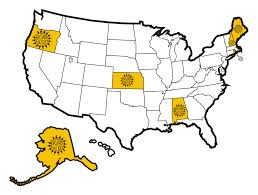
Only 6 out of the 52 states allow adoptees access to their Original Birth Certificate in the same manner as non-adopted persons. These states are: Alabama, Oregon, Kansas, New Hampshire, Maine, and Rhode Island.

Original Birth Certificate For Adoptees Born In Closed Records States
At the time of my adoption in 1944, there was a stigma attached to being an adoptee. That is because from the time of the Jutes (criminality) and Kallikak (mental retardation) studies in the late 1800s and early 1900s, it was believed such characteristics as "feeblemindedness" and "criminal behavior" were inherited. It is from this belief the concept of the "Bad Seed" was developed because the presumption was respectable women, meaning married women of the middle and upper classes, did not get pregnant out of wedlock and did not give up their child for adoption. Thus, the children made available for adoption were "Bad Seeds" produced by women and families that were the moral dregs of society.
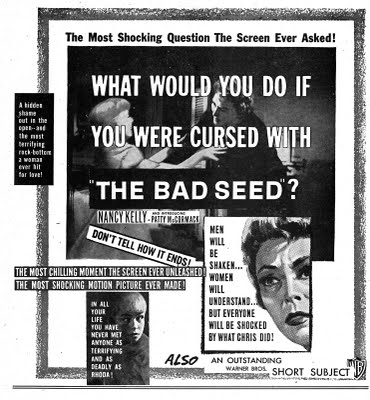
1956 Movie "The Bad Seed"
All of this conjecture was "documented" by the "science" of the time that was highly influenced by academic America's fixation with the study of Eugenics; that is, the belief and practice of improving the genetic quality of the human population. It is the same belief in the validity of Eugenics that Hitler and the Nazis used to dehumanize Jews and the reason the Third Reich needed the Endlosung (Final Solution) to exterminate Jews in the Holocaust.
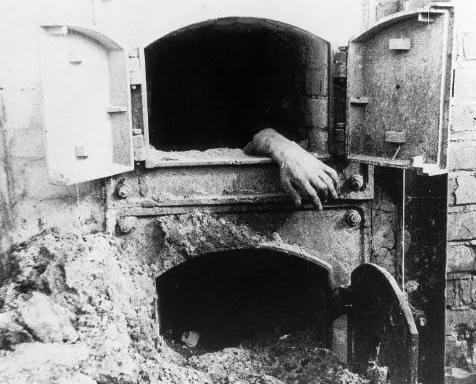
Holocaust
The Jukes family was described by Richard L. Dougdale in 1877 in, The Jukes: A study in Crime, Pauperism, Disease, and Heredity.
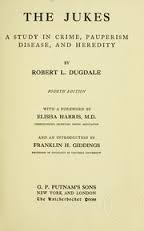
Jukes Family
A follow-up study was published by Arthur H. Estabrook of the Eugenics Records Office at Cold Spring Harbor, New York, in his 1916, The Jukes in 1915.
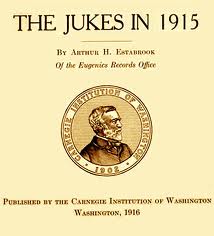
Jukes Family 1915
The Kallikak family was described by Henry H. Goddard in the 1912, The Kallikak Family: A Study in the Heredity of Feeble-Mindedness.
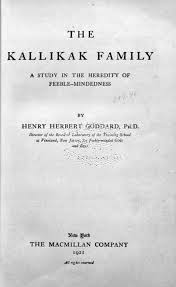
The Kallikak Family
Other surnames used as family aliases in similar studies of the late 19th and early 20th centuries include: Zeros, Nams, Happy Hickories, Doolittles, and the family of Sam Sixty that was named after Sam's IQ which was 60. All of these pseudonyms reflect the nature of the "abnormalities" of the family they document.
This is why many adoption agencies and attorneys told adoptive parents never to tell their children they were adopted. The theory was by not telling their child they were adopted, the adoptee was given a "clean slate" without the shameful label of "bastard" hung around their neck while at the same time a "seamless garment" was created between the adoptive parents and their adoptive child.
This was true in my case becasue I remember when my mother told me I was adopted. I was in first grade and standing beside her at the stove as she was making chocolate pudding. She told me, "I have something to tell you. You are being teased at school about being adopted so I have to tell you. If you were not being teased, I would never tell you. You are adopted. Now, its out in the open. But, I never would have told you if you weren't being teased so lets not talk about it again."
I remember I was immediately struck by two things. First, my mother never looked at me while she was telling me I was adopted. Secondly, after she told me, I "knew" there was something very wrong about being adopted so that meant there was something very wrong about me.
From that time on, I became the poster boy for being "The Good Adoptee". The Good Adoptee is the one who never thinks about their biological mother, father, or family, and never, never asks their adoptive parents about their family of origin.
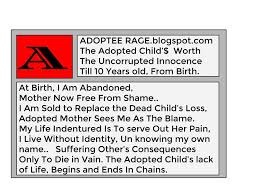
The Good Adoptee
However, that was to be only the first example of my parent's secretiveness about family matters. I was about 7 years old when I answered a knock on the front door. A young woman asked to speak to my father and told me her name was Jean. My mother, who was in the kitchen, heard her and came running into the living room screaming for her to get off the porch. My mother than literally pushed her off the porch, down the steps, and along the sidewalk until they got to a waiting car. Later that night after I was in bed, I heard my parents arguing about what had happened.
During that argument, I learned Jean was my father's daughter by a previous marriage and I would later learn she had wanted to see her father one time before she moved to Florida. I would also learn many years later that as a condition of marriage, my mother made my father promise he would never see his ex-wife or daughter again even though they lived in the same town.
As shocking as this was to me at the time, I had no idea my mother also had a secret; no, make that two secrets. My father grew flowers in part of our garden and every weekend we visited the cemetery to put flowers on the graves. One of the grave sites had a large marker with the name "Van Alstine" which I was told was my mother's family. When I was about 10, I decided to ask who the ground level marker with the name "Rosemary" was for becasue it was set off a little from the Van Alstine plot but not near another. My mother got red in the face and began to cry which was a common response for her when her emotional buttons were pushed. By the time we got back to the car, she had composed herself and told me Rosemary was her daughter by a previous marriage who had been hit by a car and killed when crossing the street when she was 13 years old.
My mother's second secret was revealed when I became the president of the Episcopal Youth Fellowship at our church at the beginning of my senior year in high school and the priest told me I had to appear before the Vestry with my proposed budget. I must have hesitated becasue the next thing he told me was, "Don't worry, your uncle is the Senior Warden."
I was confused becasue the only uncles I knew were my mother's brother who lived in Springfield and my father's brother who was a member of the Second Congregational Church. When I told the priest these were the only uncles I knew about, he told me to ask my mother about my uncle. That night when I asked her about this other uncle, she went through the same histrionics but then told me his name and that he was the husband of her sister.
Sister? I didn't even know she had a sister much less she and her husband attended the same church as I had attended all of my life.
My mother then told me the whole story. Her sister, Susie, was well off and her family was at the higher end of the economic ladder in our small town while my family was definitely blue collar working class. However, when my grandfather could no longer live alone, he lived with my parents. After he died, my mother asked Susie to pay half of his bills and burial expense. She refused to do so on the basis my mother had "kept their father from her all the years he lived with her". Thus, Suzie maintained she was not responsible for any of his debts. From that time on, my mother and her sister agreed to go to different church services and never spoke to one another again.
What I remember most about Four Corners Elementary school is boredom and that I spent a lot of time looking out the window and daydreaming. In fact, I can only remember five experiences in elementary school and they illustrate how little interest I had in academics. The earliest memory is from second grade where we learned to Square Dance. I greatly enjoyed Square Dancing and one day our teacher told the class she had chosen my square to go to each classroom to demonstrate the "Spanish Caballero" dance. After that, she told my square to come to the front of the room so everyone could see us do the dance after which she named me and my partner as the best dancers.
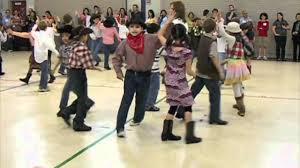
Spanish Caballero Square Dance
However, my memory from third grade is quite different and I thought then, and still do today, it was quite funny. Our teacher was getting ready to show a filmstrip but I was talking. So, as punishment, she told me to stand against the wall outside the classroom. The filmstrip began and I could hear her narrating. Then I became aware of flashes of light above me. When I looked up, I could see a big window and in the window was the reflection of the film strip.
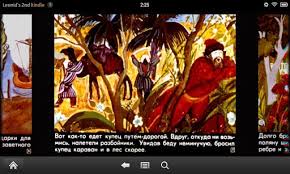
Film Strip
When I was told to come back into the classroom, our teacher had me stand in front of the class and asked me how I felt about not being able to see the filmstrip. With great glee, I told her how I had watched the filmstrip in the window at which time the class exploded with laughter.
At recess and at lunch, the boys often played a game we called "Jailbreak". We played Jailbreak behind the school becasue there was a concrete ramp with concrete walls leading from ground level to the basement floor level of the cafeteria. The game was played by several boys being the prisoners standing by the cafeteria door. Other boys would be the guards and would stand at the top of the ramp. When ready, the prisoners would rush the guards and the guards would try to keep them in the prison. While the game itself was quite banal, the fun part was seeing who got hurt when they scraped their elbows and knees on the concrete and had to go to the principal for first aide.
Our school was a two story brick building with iron fire escapes for the people on the second floor. Grades 3-5 were on the second floor becasue the principal's 6th grade room was on the first floor. When the fire alarm rang, we were to go down the fire escape row by row from those nearest the door first to those farthest away from the door last.
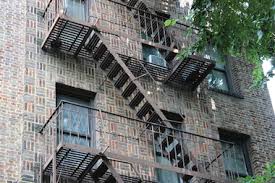
School Fire Escape
It did not take long for the girls to hate fire drills becasue these were the days when girls had to wear either a dress or skirt to school. Much to the girls' embarrassment, it did not take the boys long to see what the girls did not want us to see when we looked up at them coming down the fire escape.
Every year on May 1st or the closest school day to it, the school held its May Festival that included each class doing the May Pole Dance.
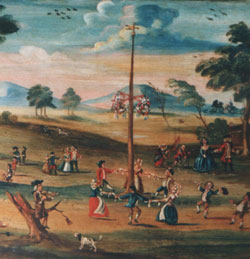
Sixteenth Century Maypole Dance
The earliest evidence of Maypole dancing is found in Iron Age Germany and was associated with the fertility rites of Spring. It survived the advent of Christianity albeit without the fertility overtones and the May Festival became a quasi-Christian holiday in Medieval Europe. The holiday was celebrated on either May 1st which is May Day, Pentecost, or on Whitsunday in the English tradition, using the Julian Calendar introduced by Julius Caesar in 46 C.E. to replace the Egyptian Calendar used by the Romans.
The Maypole dance is performed by 10 or more dancers holding colored streamers walking in opposite directions and weaving in and out as they walk. There are different dances that end up making specific patterns of colored ribbons on the Maypole.
As there is a set number of dancers, it was an honor to be selected to do the May Pole Dance for your class. Parents were invited and there were plenty of games and food to eat. When I was in 5th grade, I had been selected to be one of the dancers but had done something wrong and our teacher told me I would not be a dancer. Of course, I had already told my mother I was going to be a dancer and she would be there. I did not want to tell her what had happened, so I spent considerable time dreaming up excuses to tell her after the fact when she asked why I wasn't a dancer.
However, just as our class was about to leave the classroom to go to the playground, our teacher took me aside and asked if I had learned my lesson. I told her I had and she told me she would let me be one of the boys who stood on the May Pole Platform to keep it from falling over.
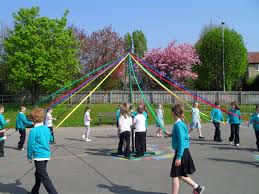
Modern Maypole Dance With Boys Standing On The Platform
I don't remember how I explained to my mother I was not a dancer, but she was satisfied with my explanation becasue we had a good time for the rest of the day.
It is during my elementary school years that I remember a special treat on hot summer days. This was a time when some people still did not have refrigerators but had an icebox in the kitchen. An icebox had a large compartment to store foot and a smaller compartment to store a large block of ice.
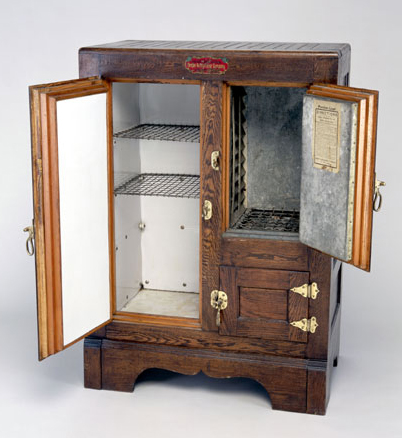
Traditional Ice Box
So, what was my treat on hot summer days? Greenfield had an "Iceman" who was a Native American we boys called "Warhorse" and when he stopped to deliver a huge block of ice to a customer, he chipped off pieces for us to suck on. I soon discovered on hot summer days, there is nothing that compares to sucking on a piece of freshly chipped ice.
The old adage is, "You can never go home".
My Boyhood Home
Yet, I have often thought it would be fun to knock on the door and tell whoever answers I grew up in this house and ask if I could take a walk-through. We moved to this house the year before I started Kindergarten, I lived there until I went away to college, and my parents continued live there until my father retired and they moved to Florida. However, there are two differences between this photo and the house as it was when we lived there. First, there was no picket fence or ramp. Secondly, the garage has been replaced.
This house holds many fond memories for me. When I lived there, the driveway was dirt and had a considerable slope toward the garage. I learned to ride a bike by coasting down the driveway and through the space between the house and garage until I either fell into the rose bushes or ran into the clothes posts in the back yard. These experiences prompted me to be a quick learner and I was soon riding on the street.
One of my earliest memories is that shortly after we moved in, a dump truck backed down the driveway and dumped its load of sand just off the driveway next to the garage. I thought I was the luckiest boy in town. I didn't just have a sandbox, I had a whole truck load of sand within which to play.
My father owned the building lot next to our house beyond my sand pile and that is where he had his garden. He grew vegetables in most of it, but had a portion where he raised flowers. However, before he planted his first garden, he had a farmer come with his tractor and plow the area. The next day, the farmer came back with a load of cow manure and harrowed it into the ground. Even so, for the next several weeks whenever you were near our house it smelled like you were standing at the wrong end of a cow.
My father had a proverbial "green thumb". He not only grew vegetables and flowers for the family, he propagated his own Dahlias creating new varieties. The Franklin County Fair held each Fall had begun as an agricultural exposition, but by the time I came along it had a full midway of rides and games.
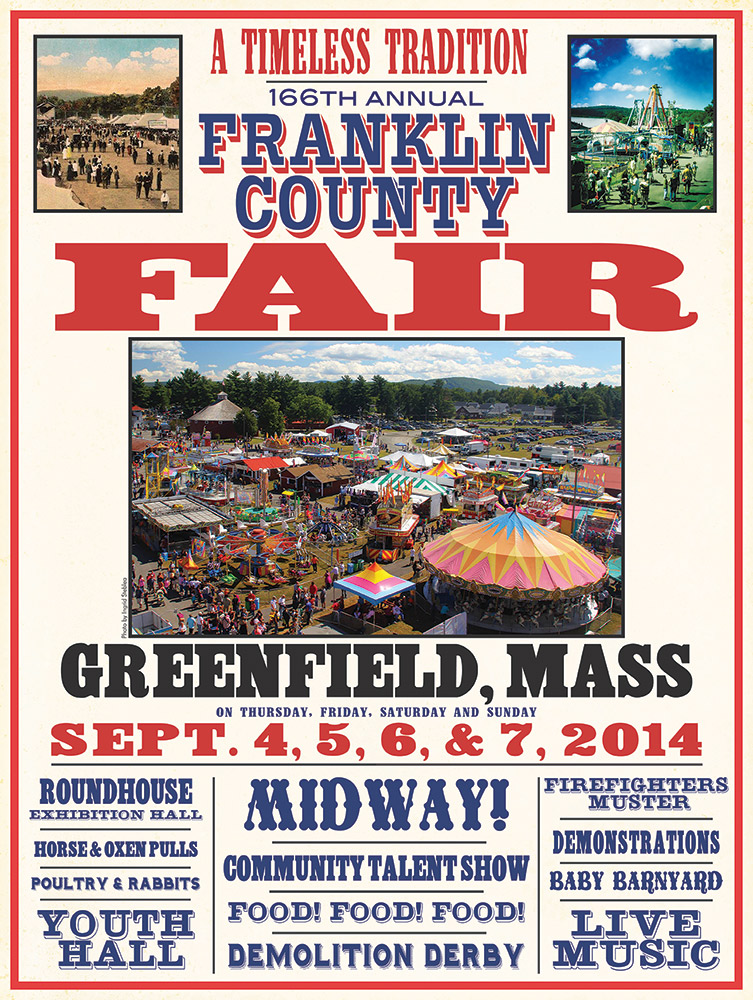
Yet, much pride was taken by people like my father who took their vegetables and flowers to be judged at the County Fair. Much to his credit, my father's hard work payed off because I cannot remember a year his flowers, especially his Dahlias, did not win prizes.
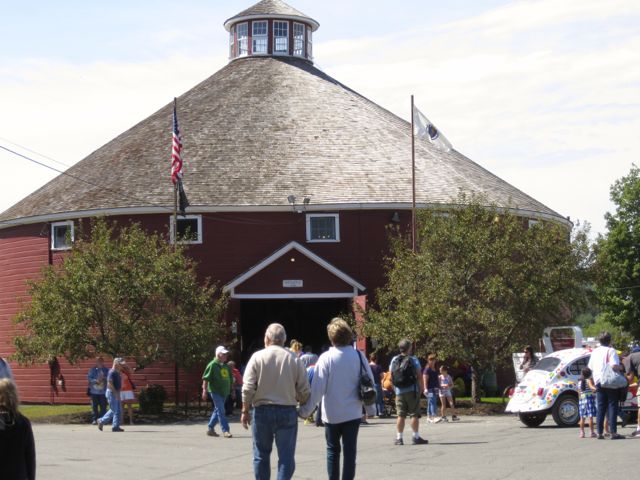
Franklin County Fair
The Roundhouse Where Vegetables and Flowers Were Exhibited and Judged
While I had little interest in the exhibits in the Roundhouse and could not ride most of the rides because they made me sick to my stomach, I loved the rifle arcade. I was a good shot by the time I was 13 becasue by that time I had earned my Boy Scout Rifle Merit Badge. The two main targets were lines of ducks passing in front of you and a big Bulls Eye on the top of each corner of the arcade. Finding the ducks too easy to hit, I would take my 50 shots at the Bulls Eye becasue if you hit the small center circle, a siren that could be heard all over the fairgrounds went off. And, if you could hit the circle with consecutive shots, the siren got louder and you could make it last for several minutes. When that happened, people knew there was a marksman at the arcade and would crowd around often paying for him to "do it again".
So, for me, the rifle arcade was double fun. First I got to show my prowess with a rifle and secondly other people paid to watch me do it.
When I was in elementary school, my mother decided she wanted to make money by raising chickens. My father built a chicken coop large enough for an incubator and 500 day old chicks. He then built a fence large enough to hold 500 chickens. My mother raised capons (castrated chickens) so about every 90 days we had a new load of chicks delivered.
In the winter when it snowed, I shoveled a path from the back porch to the clothes posts and under the clothes lines so my mother could hang out the washing. By mid-winter, the shoveled snow around the clothes posts was over my head.
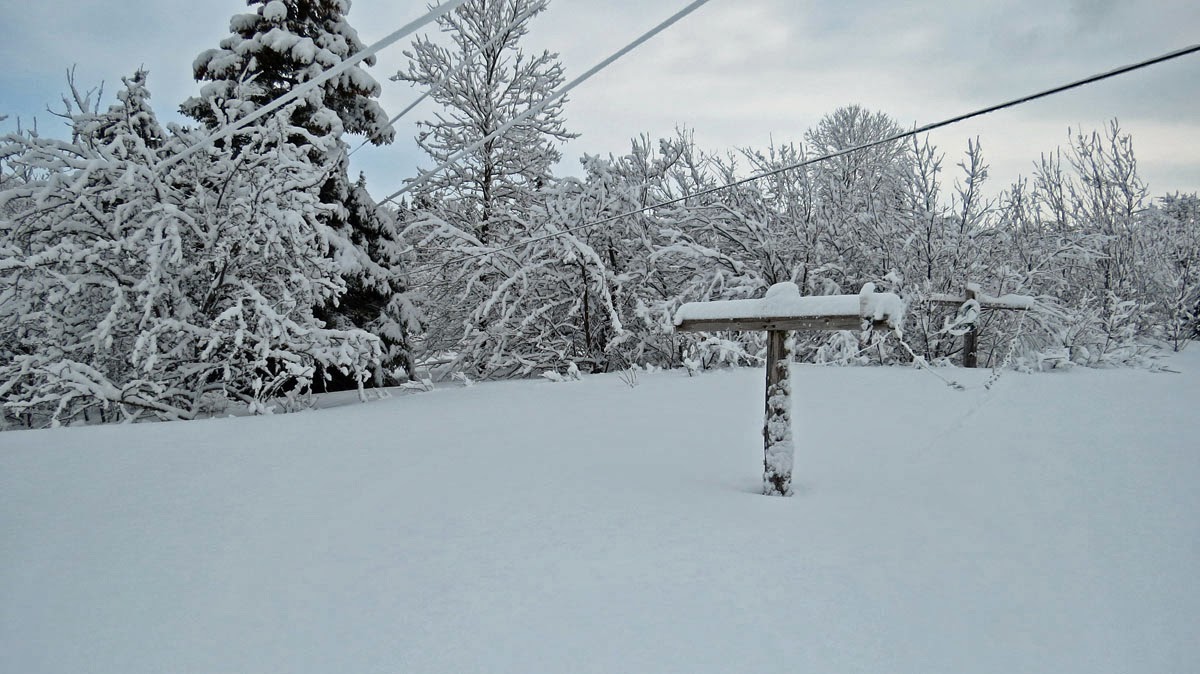
Snow Under Clothes Posts
In fact, I can remember many winters where the 8 foot high top of the clothes posts were completely buried in snow--not from what I had shoveled--but proof our accumulated snow falls were more than 8 feet deep with more to come.
The same thing happened shoveling snow off the driveway. By mid-winter, between the amount of snowfall combined with the snow piled up in front of the driveway by snowplows going down the street, there were piles of snow so high at the end of the driveway it was impossible to see over them. So, someone had to stand in the street to be sure no cars were coming before our car could back out of the driveway.
Of course, the snow plows also piled up huge mountains of snow on each side of the street. To me and my friends, these "snow mountains" made perfect forts for us to launch snowball fights.
However, what I liked best about living in this house is the property extended back over a 100 yards to Cherry Rum Brook and was covered with pine trees and white birch trees. My friends and I spent many happy hours cutting down trees with our hatchets to make a bridge over the brook and Lean-tos to give us shade. On warm summer nights, we camped out in our Lean-tos.
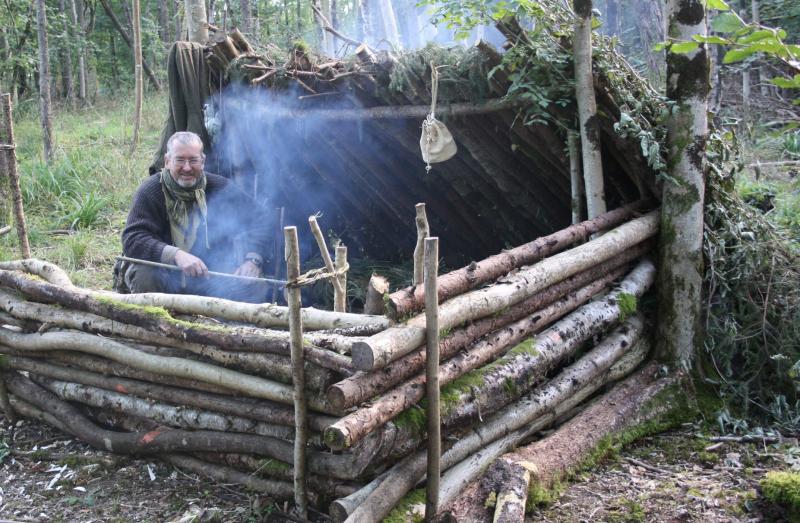
Lean-to With Enclosure
We would start building our Lean-tos by making a frame for the 45 degree angle part of the Lean-to and then cover the frame with pine boughs. Sometimes, we would expand the Lean-to by building log walls in front of it.
And of course, we kept our fishing poles there so we could fish whenever the urge struck us.
In addition to the fun Cherry Rum Brook held behind our house, by junior high school we were aware that it began at the old Ice House Pond, well actually much farther East but to us boys it began at the Ice House Pond. It was called the Ice House Pond becasue before electricity and refrigeration, men cut huge chunks of ice from the pond and stored them in the Ice Hose between heavy layers of sawdust that provided insulation to keep them from melting even in the summer.
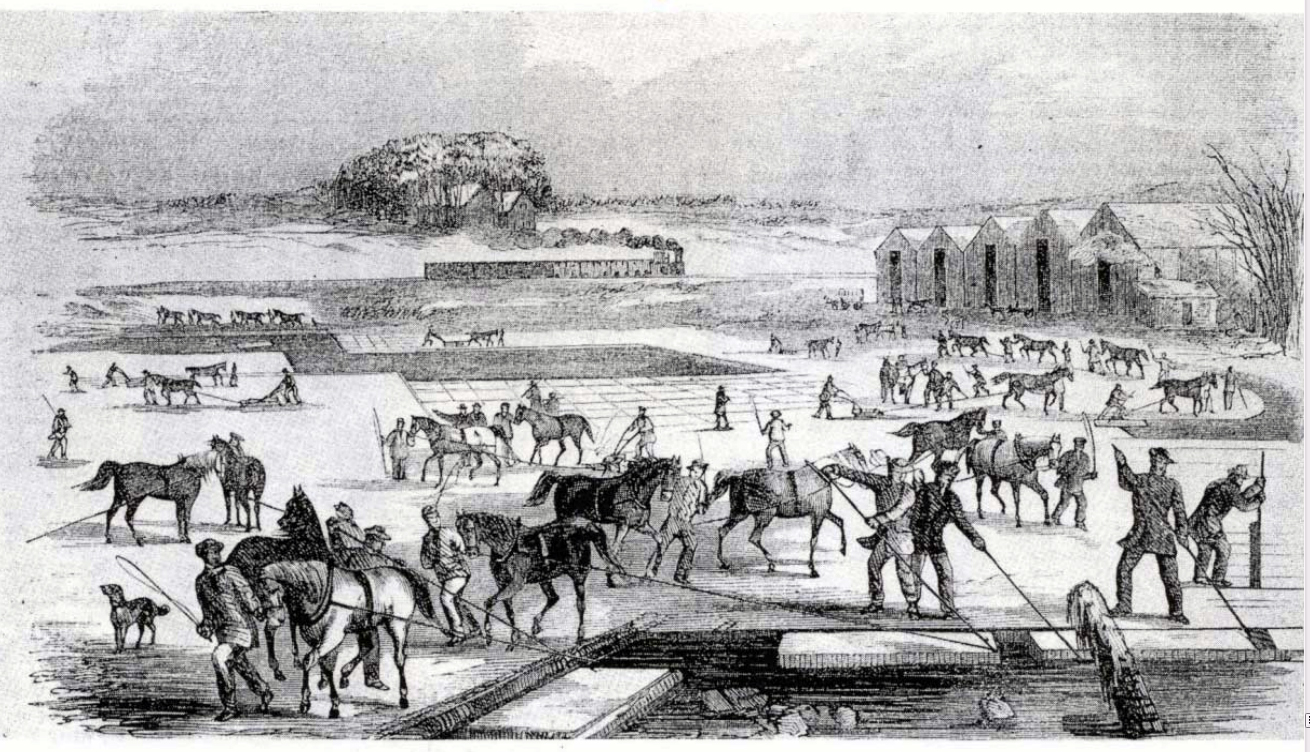
Harvesting Ice
My father told me as a young man, he would go to the Ice House Pond on weekends to make extra money harvesting ice.
However, by time I came along the Ice House had long been closed and we used the pond for fishing in the summer and playing hockey in the winter. The Ice House Pond had a spillway that allowed the water to continue Westward for about 2 miles where it became the back boundary of our property. After that, it continued to flow Westward for another mile or more until it reached Nash's Mills Pond.
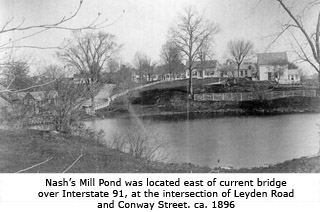
Nash's Mills Pond
Nash's Mills had been long closed and in its place was the social building of the First Congregational Church. Again, we fished there in the summer and played hockey in the winter. In fact, it would get so cold we would build a bonfire at the East end of the pond, on the ice, take off our skates and sit on a log while holding our skates over the fire by sticking a tree branch into them. It was not long before our skates, and our feet held over the fire were warm, and we were back playing hockey again.
However, looking back the best times I had in that house were winter evenings when my father would take me into the basement with him. The basement was not heated, but his workshop was next to the furnace and provided plenty of heat if you wore a jacket. Not only did it give us time to talk "man to man", but it was during these times he taught me how to use hand tools and do carpentry. Once I became proficient working on odds and ends of wood from his projects, he taught me how to build bird houses, shoe boxes, and other utilitarian things.
High school years became filled with sports, the Order of DeMolay, and my girlfriend, which left little if any time for academics which suited me fine becasue I had no interest in them.
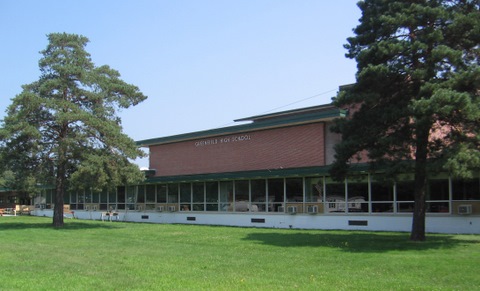
Greenfield High School 1958-2013
To make the proverbial long story short, I was a jock for all seasons. I played baseball, basketball, football, hockey, golf, tennis, and wrestled. Some sports I played in high school.but I also played baseball in Little League and Pony League as well as basketball in the YMCA Church League and town's Recreation League. In fact, when I was 14 years old and heading for high school, I had no interest in girls romantic or otherwise.
Greenfield had weekly Band Concerts during the summer that was held outdoors and boys would go in groups and spend the evening walking around looking at the girls. This is what I was doing at the last Band Concert of the summer before my freshman year when my life dramatically changed.
A mutual friend introduced me to a girl I knew in the context of attending the Adele Carlton School of Dance where we took ballroom dancing lessons. However, that night as we walked around holding hands, it felt like my heart would explode. In a matter of a couple of hours I had gone from having no interest in girls to literally falling in love. I walked her home, asked her if she would go steady with me, and when she said "yes", I kissed her. For the next two and one-half years we were inseparable until her family moved away.
One of the things we had in common was she was a member of Rainbow which is an organization for young women sponsored by the Eastern Star and I was a member of the Order of DeMolay which is an organization for young men sponsored by the Freemasons. As such, we attended many formal Balls sponsored by the Shriners where we got to show off our ballroom dancing skills. However, we liked all kinds of dancing including rock and roll and regularly attended the Friday night dances held for teenagers at the YMCA during the school year and those held at the Holy Trinity Catholic School basement during the summer. The Springfield television station had a live Saturday dance show like American Bandstand. We appeared on it and much to our surprise won the "Best Dancers" contest so we got to dance to half of the next record by ourselves. Additionally, her father played fiddle in a square dance band in Newfane, Vermont, where we would dance the night away in the Hall above the Volunteer Fire Station to dances like "Red Wing" and "48 Swing".
That said, our "togetherness" transcended dancing. She played the flute, piccolo, and glockenspiel in our high school marching band and the year I hurt my knee and could not play football, I played the snare drum. In the winter, we would go to Highland Pond to go ice skating and spent summers at the swimming pool where we idled the time away sunbathing.
The Order of DeMolay was created in 1919 by Frank S. Land who was a Freemason in Kansas City, Missouri.
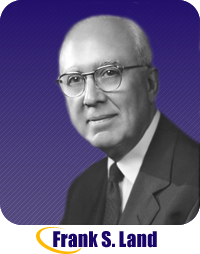
One night, he received a phone call from the widow of a Brother Mason asking for help for her son whom she said needed "a man in his life". It was not long before eight more young men were a part of the group and these nine young men were the founding members of the Order of DeMolay with Frank S. Land as their adviser who was known as "Dad" Land.
The Order of DeMolay grew quickly and soon spread out across America and then internationally. As for me, it did not take long for me to realize DeMolay and I were a perfect fit because I loved the pageantry and made its values my own. I am proud to say that in my senior year of high school, I was elected Master Counselor of the Greenfield Chapter Order of DeMolay.

The DeMolay Emblem
Each element of the DeMolay Emblem has a particular significance and meaning. They are:
The CROWN: Is symbolic of the Crown of Youth and constantly reminds a DeMolay of his obligations and the seven precepts of the Order.
The TEN RED RUBIES: Honor the Founder and the nine young men whose ties of friendship drew them together in the formation of the Order.
The HELMET: Is emblematic of chivalry, without which there can be no fineness of character.
The CRESCENT: Is a sign of secrecy and constantly reminds DeMolays of their duty never to reveal the secrets of their Order or betray the confidence of a friend.
The five-armed WHITE CROSS: Symbolizes the purity of your intentions to always remember the motto of the Order, “No DeMolay shall fail as a citizen, as a leader, and as a man.”
The CROSSED SWORDS: Denote justice, fortitude and mercy. They symbolize the unceasing warfare of DeMolay against arrogance, despotism and intolerance.
The STARS: Surrounding the crescent are symbolic of hope and should always remind us of those obligations and duties which one brother of the Order owes to another.
The Order of DeMolay has seven Cardinal Virtues or Precepts that constitute the basic ideals and essential teachings of the Order. They are: Filial Love, Reverence for Sacred Things, Courtesy, Comradeship, Fidelity, Cleanness, and Patriotism.
The meaning of the elements on the DeMolay Emblem and its Cardinal Virtues or Precepts became the building blocks of my formative teenage years. As such, I made them my own as I became a man and continue to live by them today.
The new Greenfield High School opened in September 2014 and will be completed in three stages.

Architectural Rendering Of The New Greenfield High School
Even though I had no interest in academics, I will always remember two teachers. The first was my senior year English teacher and the second was my art teacher.
There were several teachers who taught senior English but one was feared by everyone. The Urban Legend was it was so hard to earn an "A" in her class if you did, and your SAT mathematics score was high enough, the rest of your SAT didn't matter because you would be accepted by the University of Massachusetts at Amherst.
Needless to say, she was my senior year English teacher and if I did not pass senior English I would not graduate. However, my reputation as a reluctant scholar preceded me and she told me to see her after school the first day of class. At that meeting, she made it absolutely clear she would not let me slide because I was an athlete. She also told me there was no way I was going to pass her class.
Then, she made me an offer I couldn't refuse. I would report to her every morning a half-hour before Home Room and she would teach me all I needed to know to pass her class which entailed writing a college level term paper that determined whether or not a student passed senior English.
We began the next morning at square one identifying parts of speech and how they fit together. From there, I learned how to write a three word sentence using a noun, verb and adverb or adjective. When I could write a coherent paragraph, I was introduced to writing both a critical and rhetorical precis that are highly specialized types of literary summary. The format was she would give me one word and I would have 10 minutes to create a precis regarding that word.
To her great credit, my senior English teacher not only made a silk purse out of the proverbial sow's ear, through her effort and guidance I developed a love of writing--to say nothing about being able to writing college term papers with ease--that has continued throughout my life.
The second teacher I fondly remember is my art teacher. Because I was an athlete and the school wanted to maintain my eligibility to play sports, I was assigned to an art class not only every year in high school (art was an elective to be taken only one year), but in my junior and senior years I had two art periods per day.
What first drew me to my art teacher was his non- judgmental attitude toward students and their art because he believed everyone has artistic talent and it was his job to draw it out. He also stayed after school most days until four o'clock or later, and allowed students who were particularly interested in art to come to his room after school for art lessons. I had always been interested in art, so whenever I had a free afternoon you would find me taking an art lesson.
However, over time he became more than simply my art teacher; he became my mentor. We would talk about anything and everything and he would give me the benefit of his experience and advice never telling me what to do, but rather giving me the information and tools I needed to make my own informed decision. One of the things we talked about much of my senior year was whether I should to go to the Massachusetts College of Art after high school and become an art teacher as he suggested or become an art major specializing in painting.
We also talked a lot about what is often a taboo subject between teachers and students and that is religion. He was a Unitarian who was well versed in what Christian denominations believed and I learned a great deal about comparative religion from him as well as sharpening my own beliefs in light of them. These discussions very important to me, becasue since I was in elementary school I had wanted to become an Episcopal priest. In the end, I decided to go to the University of Tampa where I could be an art major but also take the courses I needed to be prepared for seminary.
However, it was my lack of interest academics that had led me to the droning voice of my senior year guidance counselor, Mr. Cox. After reviewing my academic deficiencies, he finally said, "You were always a reluctant scholar. Look at your SAT scores. No college will accept you. Perhaps you can get a job at a gas station or go in the Army."
Mr. Cox was right, well almost right. I had done just enough to graduate from high school at the bottom of my class between my two best friends, Nip and Tuck.
And, by some miracle, I was accepted by the University of Tampa as an art major.
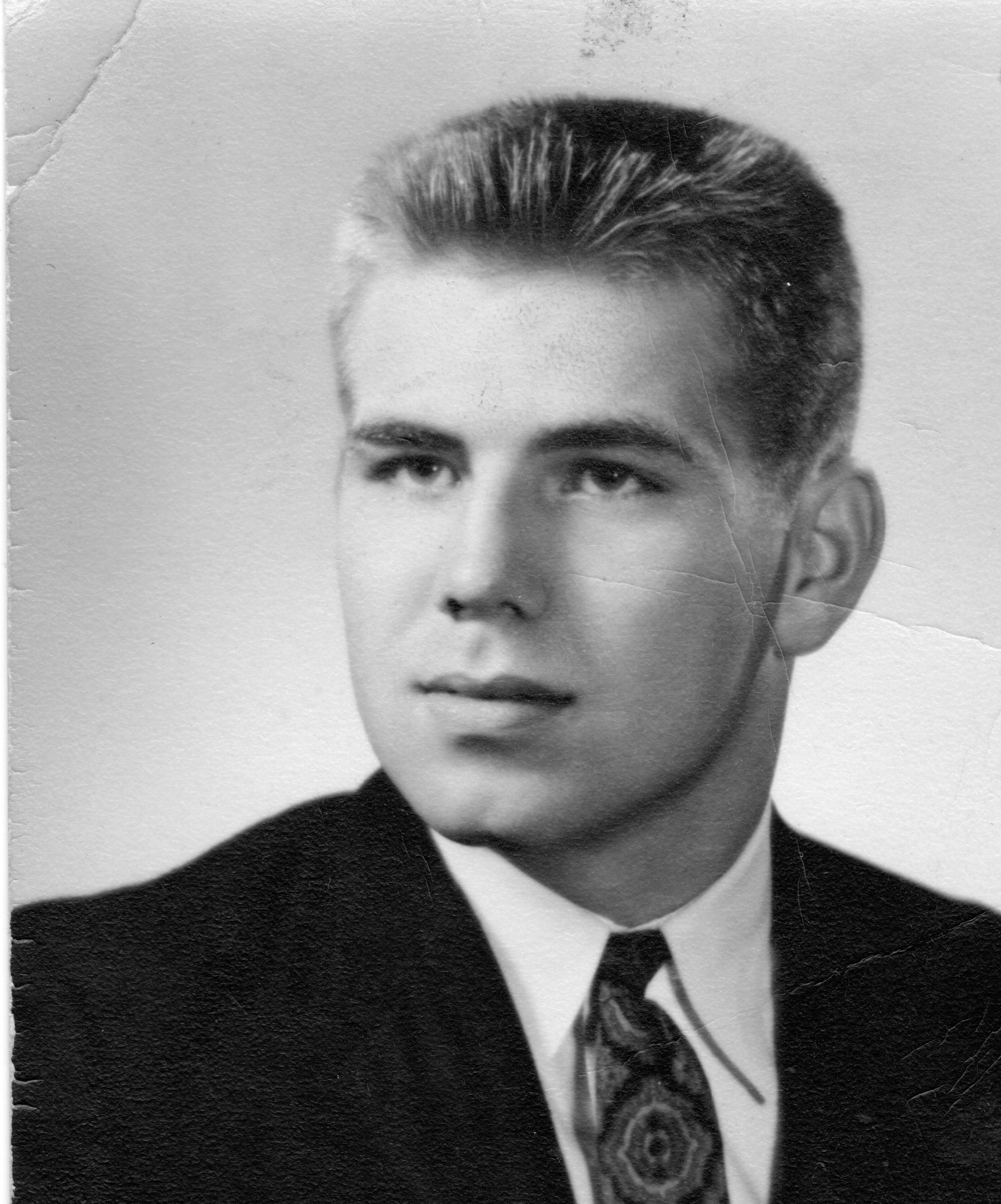
High School Graduation, 1961